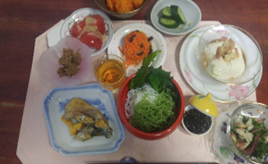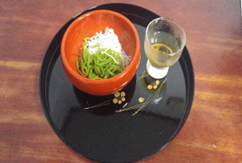A summer tradition, fish somen noodles
Yoshi Doi
 |
 |
When spring comes, fish somen noodles, which are limited to spring and summer, are lined up on the sales floor. Department stores have different items depending on the season. Yesterday, I received fish somen noodles for the first time this year. I’ve loved it since I was a kid, and I don’t buy many processed products, but I do buy fish somen and shinjo. Depending on the region, there are people who don’t know fish somen, and people who have never eaten it.
When I sent fish somen to Hokkaido before, I was surprised when I was told that it was the first time for the shop to deliver it to Hokkaido. Even in the Kansai area of Osaka and Kobe, there are people who do not know about fish somen, and I learned that it is a unique food culture of Kyoto.
Somen has a long history, dating back to the Nara period. It is said that the roots of this dish are “Sakubei”, which was introduced from China by Japanese envoys to Tang Dynasty China. It is made into a rope shape by kneading flour and glutinous rice flour. Also known as barley rope, it seems that it was eaten boiled and dressed with soy sauce or vinegar, or dipped in salty azuki bean soup. In the days when soy sauce was not yet available, somen was seasoned differently than it is today. Was it some kind of candy?
During the Heian period, it was eaten in the imperial court following a Chinese legend that people who ate sakumochi on Tanabata were protected from illness. Later, in the Muromachi period, Yasaka Shrine’s “Gion Shugyo Nikki” contained a description of “Tanba somen koji menjo : Tanba somen public affairs exemption” which was the first documented article about somen.
After that, in the Edo period, there was a custom to offer somen noodles for Tanabata, and the making of somen flourished. Western Japan has many famous types of somen, such as Miwa somen from Nara, Ibonoito from Hyogo, and Shodoshima somen from Kagawa.
After that, in the Edo period, there was a custom to offer somen noodles for Tanabata, and the making of somen flourished. Western Japan has many famous types of somen, such as Miwa somen from Nara, Ibonoito from Hyogo, and Shodoshima somen from Kagawa.
Fish somen is manufactured and sold at Kamabokoya. Uo-somen was created by Kyoto kamaboko craftsmen in the Edo period with a sense of fun. It has become an indispensable feast for the Gion Festival in summer. In the hot and humid summer of Kyoto, there are many people who can eat fish somen even if they do not have an appetite. Somen with conger pike is a staple in Kyoto, but conger eel dishes, conger pike sushi, and somen with conger pike are staples of Kyoto in the summer. Conger pike is a fish with strong vitality, and hats off to the chefs of Kyoto who cut the bones of the conger pike into small pieces to make it easier to eat, instead of throwing it away in the soup stock in other regions. The Gion Matsuri is also known as the Hamo Matsuri (conger pike) festival because the conger pike is eaten deliciously, making it a standard summer treat in Kyoto.
The end of document
